The potential role of dietary polyphenols in Parkinson’s disease
advertisement
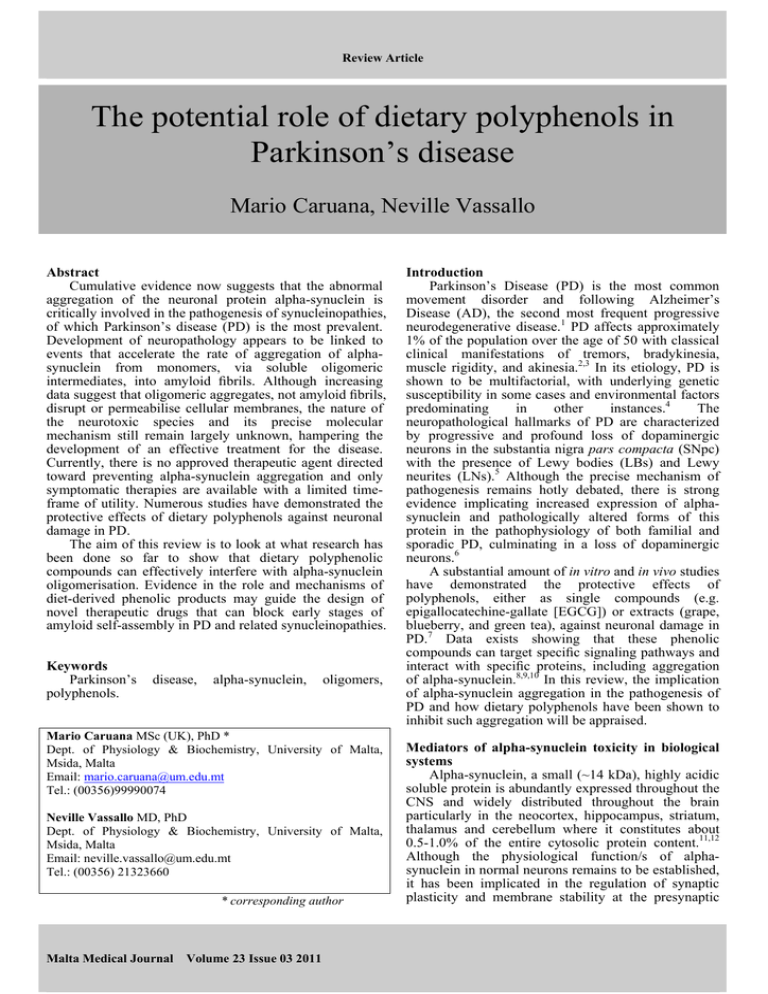
Review Article The potential role of dietary polyphenols in Parkinson’s disease Mario Caruana, Neville Vassallo Abstract Cumulative evidence now suggests that the abnormal aggregation of the neuronal protein alpha-synuclein is critically involved in the pathogenesis of synucleinopathies, of which Parkinson’s disease (PD) is the most prevalent. Development of neuropathology appears to be linked to events that accelerate the rate of aggregation of alphasynuclein from monomers, via soluble oligomeric intermediates, into amyloid fibrils. Although increasing data suggest that oligomeric aggregates, not amyloid fibrils, disrupt or permeabilise cellular membranes, the nature of the neurotoxic species and its precise molecular mechanism still remain largely unknown, hampering the development of an effective treatment for the disease. Currently, there is no approved therapeutic agent directed toward preventing alpha-synuclein aggregation and only symptomatic therapies are available with a limited timeframe of utility. Numerous studies have demonstrated the protective effects of dietary polyphenols against neuronal damage in PD. The aim of this review is to look at what research has been done so far to show that dietary polyphenolic compounds can effectively interfere with alpha-synuclein oligomerisation. Evidence in the role and mechanisms of diet-derived phenolic products may guide the design of novel therapeutic drugs that can block early stages of amyloid self-assembly in PD and related synucleinopathies. Keywords Parkinson’s polyphenols. disease, alpha-synuclein, oligomers, Mario Caruana MSc (UK), PhD * Dept. of Physiology & Biochemistry, University of Malta, Msida, Malta Email: mario.caruana@um.edu.mt Tel.: (00356)99990074 Neville Vassallo MD, PhD Dept. of Physiology & Biochemistry, University of Malta, Msida, Malta Email: neville.vassallo@um.edu.mt Tel.: (00356) 21323660 * corresponding author Malta Medical Journal Volume 23 Issue 03 2011 Introduction Parkinson’s Disease (PD) is the most common movement disorder and following Alzheimer’s Disease (AD), the second most frequent progressive neurodegenerative disease.1 PD affects approximately 1% of the population over the age of 50 with classical clinical manifestations of tremors, bradykinesia, muscle rigidity, and akinesia.2,3 In its etiology, PD is shown to be multifactorial, with underlying genetic susceptibility in some cases and environmental factors The predominating in other instances.4 neuropathological hallmarks of PD are characterized by progressive and profound loss of dopaminergic neurons in the substantia nigra pars compacta (SNpc) with the presence of Lewy bodies (LBs) and Lewy neurites (LNs).5 Although the precise mechanism of pathogenesis remains hotly debated, there is strong evidence implicating increased expression of alphasynuclein and pathologically altered forms of this protein in the pathophysiology of both familial and sporadic PD, culminating in a loss of dopaminergic neurons.6 A substantial amount of in vitro and in vivo studies have demonstrated the protective effects of polyphenols, either as single compounds (e.g. epigallocatechine-gallate [EGCG]) or extracts (grape, blueberry, and green tea), against neuronal damage in PD.7 Data exists showing that these phenolic compounds can target specific signaling pathways and interact with specific proteins, including aggregation of alpha-synuclein.8,9,10 In this review, the implication of alpha-synuclein aggregation in the pathogenesis of PD and how dietary polyphenols have been shown to inhibit such aggregation will be appraised. Mediators of alpha-synuclein toxicity in biological systems Alpha-synuclein, a small (~14 kDa), highly acidic soluble protein is abundantly expressed throughout the CNS and widely distributed throughout the brain particularly in the neocortex, hippocampus, striatum, thalamus and cerebellum where it constitutes about 0.5-1.0% of the entire cytosolic protein content.11,12 Although the physiological function/s of alphasynuclein in normal neurons remains to be established, it has been implicated in the regulation of synaptic plasticity and membrane stability at the presynaptic Review Article level, neuronal differentiation, regulation of dopamine synthesis, release or storage and protein networks.13,14,15 The study of protein aggregation saw a new start in the last decade, when it was discovered that protein misfolding and aggregation is the most likely cause of several human diseases such as neurological and systemic diseases.16 A characteristic of protein-misfolding diseases is the fact that soluble monomeric proteins are progressively folded into insoluble, filamentous polymers which accumulate in a disease/protein-specific manner, either as fibrillar amyloid deposits in the cytosol (‘inclusions’), or in the extracellular space (‘plaques’).17 The simple overproduction of wildtype alpha-synuclein may account for aggregation that requires a minimum concentration of the monomer. Indeed, multiplication and mutations of the alpha-synuclein gene are associated with different phenotypes of PD, most likely resulting from an enhanced alpha-synuclein monomer level.18 Substantial evidence exists showing that overexpression of human alpha-synuclein in various mammalian cells and animal models can cause apoptosis, damage cell organelles and enhance susceptibility to oxidative stress in the absence of detectable fibril formation.19 The roles of the various physical forms (i.e. monomers, oligomers or fibrils) of alpha-synuclein in PD pathogenesis remains controversial. A minority of researchers consider LBs to be neurotoxic, while most others deem them to be protective.20,21 Although the cause of neurodegeneration in PD is not fully understood, substantial data from in vitro and in vivo studies supports the hypothesis that small alpha-synuclein oligomeric aggregates (rather than the fibrillar amyloid deposits or the LBs) represent the principal pathogenic species.22,23 It has been shown that alpha-synuclein soluble oligomeric forms share a common structure with other amyloidogenic proteins, such as amylin, insulin, prion protein etc. implying a common mechanism of pathogenesis.24 There is increasing evidence that these oligomers are critical species in the early stages of most, if not all, pathological aggregation and especially fibrillation reactions.25 A possible mechanism of toxicity by these transient oligomers of alpha-synuclein has been proposed showing that these oligomers can form structures with pore-like morphologies and that these pore-like structures contribute to cytotoxicity in neurodegenerative diseases by disrupting organelle membranes and hence their function.26 Many studies have recently focused on the relationship between alpha-synuclein aggregation and mitochondrial dysfunction, which is a defect occurring early in the pathogenesis of both sporadic and familial PD.27 Alpha-synuclein aggregates have been proposed to form pores in mitochondria leading to mitochondrial dysfunction and enhanced oxidative stress conditions. 28 Thus, drugs and genetic approaches with the potential to inhibit alpha-synuclein aggregation and adjust mitochondrial dynamics, function and biogenesis may help in attenuating the onset of PD. Inhibition of alpha-synuclein toxicity by polyphenols In PD, only symptomatic treatment is available at the moment, mainly by elevating dopamine levels through the Malta Medical Journal Volume 23 Issue 03 2011 administration of L-DOPA (L-3,4dihydroxyphenylalanine; Levodopa) in combination with a peripheral L-DOPA decarboxylase inhibitor.29 Currently, no disease-modifying drug therapy is available for PD, which aims to slow or halt the progression of neuronal death.30 Alpha-synuclein’s propensity to misfold and accumulate as cytoplasmic aggregates led to the hypothesis that toxicity could be prevented by interfering with the process of misfolding and aggregation.31 Besides caffeine and vitamins, aromatic-rich polyphenolic compounds from green tea, wine and other dietary food, are supposed to have a preventive or attenuating effect on PD progression.32 Polyphenolic compounds are naturally-present constituents of a wide variety of fruits, vegetables, food products and beverages derived from plants such as olive oil, tea, and red wine. In the last decade, there has been a surge in interest on polyphenols, as several epidemiological studies revealed that these compounds can promote health and protect from several chronic diseases such as cancers, cardiovascular and neurodegenerative diseases.33,34 Overall, there is emerging evidence from cultured human cell lines and animal studies that polyphenols may potentially have a protective effect against the development of neurodegenerative diseases and may improve cognitive function in patients with established neurodegenerative diseases.35 It has been argued that three important aspects need to be taken in consideration when making health claims with confidence regarding polyphenols: (i) biovailablity, (ii) epidemiological studies that investigated polyphenol-rich foods rather than pure polyphenol preparations, and (iii) that it is extremely difficult to estimate with any degree of precision the amount of polyphenols needed for potential health benefits in humans, based on concentrations used in vitro and animal studies.36 Although these are valid points to take into consideration, recent studies have shown that polyphenols can be bioavailable and cross the blood-brain barrier. For example, oral administration of the phenolic compound nordihydroguaiaretic acid (NDGA) in mice was successful in modulating amyloid aggregation pathways in vivo and prevented the development of AD neuropathology.37 It was also shown that grapederived polyphenolics do reach the brain and that systemic oral bioavailability of EGCG in rats can be increased more than twofold by formation and administration of nanolipidic EGCG particles.38,39 Such strategies may allow polyphenols to achieve therapeutically effective concentrations in clinical settings. The precise mechanisms by which polyphenols exert their beneficial actions remain unclear. Recent studies have hypothesized that their classical hydrogen-donating antioxidant activity is unlikely to be the only explanation for cellular effects.40 It was further suggested that alterations in membrane and protein functions can occur at very low polyphenol Review Article concentrations, and still have major effects on biological events.33 Thus, protein-polyphenol interactions can be relevant at concentrations much lower than those necessary to cope with a constant free radical production. Therefore, a direct action of polyphenols on protein aggregation is a very probable mechanism of the compound’s action in vivo. In fact, a survey of the current literature shows convincing evidence of the protective effect of polyphenols against amyloid cytotoxicity from in vitro to human studies. In order to better elucidate the mechanisms by which these polyphenols are acting, it is pertinent to briefly look at the striking property of these compounds to prevent and destabilize the formation of toxic amyloidogenic proteins. but which retain the bioactivity characteristic of the natural product scaffold. This insight in turn will offer prospects for identifying inhibitors such as polyphenols aimed at arresting and/or reversing the progression of PD and related synucleinopathies. Acknowledgements Research work carried out by the authors was supported by a Malta Government Scholarship to M.C. and a University of Malta grant (R09-31-309) to N.V. References 1. 2. Effects of polyphenols on alpha-synuclein aggregation During the past decade, a significant number of in vitro assays investigated the direct effect of certain polyphenols on amyloid fibril formation, with a select number of polyphenols shown to efficiently inhibit and destabilize amyloidogenic fibrillation.41,42 Other data also demonstrated that several polyphenols counteract the cytotoxic properties of alpha-synuclein aggregates directly in a cellular context.43 EGCG, the most abundant polyphenolic extract from green tea, has recently attracted much research interest in the field of protein-misfolding diseases because of its potent anti-amyloid-fibril effect. EGCG was demonstrated to efficiently inhibit fibril formation of alpha-synuclein.44,45 Specifically, it was shown that EGCG transforms large alpha-synuclein fibrils into smaller non-toxic, amorphous protein aggregates which do not cause a quantitative release of monomers or small oligomers that subsequently reassemble into larger protein aggregates.46 More recently, it was found that a group of polyphenols exhibited potent dose-dependent inhibitory activity on alpha-synuclein aggregation.9 Among the most promising polyphenols tested were green tea extract, resveratrol, catechines, baicalein and tannic acid.47 Thus, polyphenols with anti-aggregation properties appear to be potential key molecules for the development of preventives and therapeutics for PD and related synucleinopathies. 3. 4. 5. 6. 7. 8. 9. 10. 11. 12. Conclusion It is increasingly evident from published studies that misfolded and aggregated disease proteins are not simply neuropathologic markers of neurodegenerative disorders but, instead, they almost certainly contribute to disease pathogenesis. Thus paving the way for the identification of rational therapeutic agents designed to inhibit or reverse the fibrillation and aggregation of alpha-synuclein in PD could have potential disease-modifying effects. Polyphenolic compounds have been shown to regulate the toxic effects of aggregated proteins such as alphasynuclein. Detailed investigations into the mechanisms of natural phenolic products may guide the design of novel therapeutic drugs in PD which possess enhanced properties in vivo (e.g. ability to penetrate the blood-brain barrier), Malta Medical Journal Volume 23 Issue 03 2011 13. 14. 15. 16. Toda T. Molecular genetics of Parkinson's disease. Brain Nerve. 2007;59:815-823. Siderowf A, Stern M. Update on Parkinson disease. Ann. Intern. Med. 2003;138:651-658. Jankovic J. Parkinson’s disease: clinical features and diagnosis. J. Neurol. Neurosurg. Psychiatry. 2008;79:368-376 Elbaz A, Moisan F. Update in the epidemiology of Parkinson's disease. Curr. Opin. Neurol. 2008;21:454-460. Braak H, Ghebremedhin E, Rüb U, Bratzke H, Del Tredici K. Stages in the development of Parkinson's disease-related pathology. Cell Tissue Res. 2004;318:121-134. Irvine GB, El-Agnaf OM, Shankar GM, Walsh DM. Protein aggregation in the brain: the molecular basis for Alzheimer's and Parkinson's diseases. Mol. Med. 2008;14:451-464. Masuda M, Suzuki N, Taniguchi S, Oikawa T, Nonaka T, Iwatsubo T et al. Small molecule inhibitors of α-synuclein filament assembly. Biochemistry. 2006;45:6085-6094. Ramassamy C. Emerging role of polyphenolic compounds in the treatment of neurodegenerative diseases: A review of their intracellular targets. Europ. J. Pharmacol. 2006;545:51-64. Caruana M, Högen T, Levin J, Hillmer A, Giese A, Vassallo N. Inhibition and disaggregation of alpha-synuclein oligomers by natural polyphenolic compounds. FEBS Lett. 2011;585:1113-1120. Campos-Esparza R, Torres-Ramos MA. Neuroprotection by natural polyphenols: molecular mechanisms. Cent. Nerv. Syst. Agents Med. Chem. 2010;10:269-277. Beyer K. Mechanistic aspects of Parkinson’s disease: alphasynuclein and the biomembrane. Cell. Biochem. Biophys. 2007;47:285-299. Ding TT, Lee SJ, Rochet JC, Lansbury PT. Annular alphasynuclein protofibrils are produced when spherical protofibrils are incubated in solution or bound to brainderived membranes. Biochemistry. 2002;41:10209-10217. Fink AL. Natively unfolded proteins. Curr. Opin. Struct. Biol. 2005;15:35-41. Bisaglia M, Mammi S, Bubacco L. Structural insights on physiological functions and pathological effects of alphasynuclein. FASEB J. 2009;23:329-340. Abeliovich A, Schmitz Y, Fariñas I, Choi-Lundberg D, Ho WH, Castillo PE et al. Mice lacking alpha-synuclein display functional deficits in the nigrostriatal dopamine system. Neuron. 2000;25:239-252. Lansbury PT, Lashuel HA. A century-old debate on protein aggregation and neurodegeneration enters the clinic. Nature. 2006;443:774-778. Review Article 17. Stefani M, Dobson CM. Protein aggregation and aggregate toxicity: new insights into protein folding, misfolding diseases and biological evolution. J. Mol. Med. 2003;81:678-699. 18. Nishioka K, Hayashi S, Farrer MJ, Singleton AB, Yoshino H, Imai H et al. Clinical heterogeneity of alpha-synuclein gene duplication in Parkinson’s disease. Ann. Neurol. 2006;59:298-309. 19. Gosavi N, Lee HJ, Lee JS, Patel S, Lee SJ. Golgi fragmentation occurs in the cells with prefibrillar alpha-synuclein aggregates and precedes the formation of fibrillar inclusion. J. Biol. Chem. 2002;277:48984-48992. 20. Giasson BI, Lee VM. Parkin and the molecular pathways of Parkinson’s disease. Neuron. 2001;31:885-888. 21. Conway KA, Lee SJ, Rochet JC, Ding TT, Williamson RE, Lansbury PT. Acceleration of oligomerization, not fibrillization, is a shared property of both alpha-synuclein mutations linked to early-onset Parkinson’s disease: implications for pathogenesis and therapy. Proc. Natl. Acad. Sci. USA. 2000;97:571-576. 22. Karpinar DP, Balija MB, Kügler S, Opazo F, Rezaei-Ghaleh N, Wender N et al. Pre-fibrillar alpha-synuclein variants with impaired beta-structure increase neurotoxicity in Parkinson’s disease models. EMBO J. 2009;28:3256-68. 23. Winner B, Jappelli R, Maji SK, Desplats PA, Boyer L, Aigner S et al. In vivo demonstration that alpha-synuclein oligomers are toxic. Proc. Natl. Acad. Sci. U S A. 2011;108:4194-4199. 24. Kayed R, Head E, Thompson JL, McIntire TM, Milton SC, Cotman CW, Glabe CG Common structure of soluble amyloid oligomers implies common mechanism of pathogenesis. Science. 2003;300:486-489. 25. Outeiro TF, Putcha P, Tetzlaff JE, Spoelgen R, Koker M, Carvalho F. et al. Formation of toxic oligomeric alpha-synuclein species in living cells. PLoS ONE. 2008;3:e1867. 26. Kayed R, Sokolov Y, Edmonds B, McIntire TM, Milton SC, Hall JE, Glabe CG. Permeabilization of lipid bilayers is a common conformation-dependent activity of soluble amyloid oligomers in protein misfolding diseases. J. Biol. Chem. 2004;279:4636346366. 27. Büeler H. Impaired mitochondrial dynamics and function in the pathogenesis of Parkinson's disease. Exp. Neurol. 2009;218:235246. 28. Betarbet R, Canet-Aviles RM, Sherer TB, Mastroberardino PG, McLendon C, Kim JH et al. Intersecting pathways to neurodegeneration in Parkinson's disease: effects of the pesticide rotenone on DJ-1, alpha-synuclein, and the ubiquitin-proteasome system. Neurobiol. Dis. 2006; 22:404-420. 29. Lees AJ, Hardy J, Revesz T. Parkinson's disease. Lancet. 2009;373:2055-2066. 30. Olanow CW, Jankovic J. Neuroprotective therapy in Parkinson's disease and motor complications: a search for a pathogenesistargeted, disease-modifying strategy. Mov. Disord. 2005; 20:S310. 31. Beyer K, Ariza A. The therapeutical potential of alpha-synuclein anti-aggregatory agents for dementia with Lewy bodies. Curr. Med. Chem. 2008;15:2748-2759. 32. Di Giovanni G. A diet for dopaminergic neurons? J. Neural. Transm. Suppl. 2009:73:317-331. Malta Medical Journal Volume 23 Issue 03 2011 33. Fraga CG Plant polyphenols: how to translate their in vitro antioxidant actions to in vivo Conditions. Life. 2007;59:308315. 34. Scalbert A, Manach C, Morand C, Rémésy C, Jiménez L. Dietary polyphenols and the prevention of diseases. Crit. Rev. Food Sci. Nutr. 2005;45:287-306. 35. Bastianetto S, Quirion R. Natural antioxidants and neurodegenerative diseases. Front. Biosci. 2004;9:3447-3452. 36. Weichselbaum E, Buttriss JL. Polyphenols in the diet. Nutrition Bulletin. 2010;35:157-164. 37. Hamaguchi T, Ono K, Murase A, Yamada M. Phenolic compounds prevent Alzheimer’s pathology through different effects on the amyloid-beta aggregation pathway. Am. J. Pathol. 2009;175:2557-2565. 38. Smith A, Giunta B, Bickford PC, Fountain M, Tan J, Shytle RD. Nanolipidic particles improve the bioavailability and alpha-secretase inducing ability of epigallocatechin-3-gallate (EGCG) for the treatment of Alzheimer's disease. Int. J. Pharm. 2010;389:207-212. 39. Janle ME, Lila MA, Grannan M, Wood L, Higgins A, Yousef GG et al. Pharmacokinetics and tissue distribution of 14Clabeled grape polyphenols in the periphery and the central nervous system following oral administration. J. Med. Food. 2010;13:926-933. 40. Stevenson DE, Hurst RD. Polyphenolic phytochemicals - just antioxidants or much more? Cell Mol. Life Sci. 2007;64:2900-2916. 41. Masuda M, Suzuki N, Taniguchi S, Oikawa T, Nonaka T, Iwatsubo T et al. Small molecule inhibitors of alpha-synuclein filament assembly. Biochemistry. 2006;45:6085-6094. 42. Meng X, Munishkina LA, Fink AL, Uversky VN. Effects of various flavonoids on the alpha-synuclein fibrillation process. Parkinsons Dis. 2010;650794:1-16. 43. Griffioen G, Duhamel H, Van Damme N, Pellens K, Zabrocki P, Pannecouque C et al. A yeast-based model of alphasynucleinopathy identifies compounds with therapeutic potential. Biochim. Biophys. Acta. 2006;1762:312-318. 44. Ehrnhoefer DE, Bieschke J, Boeddrich A, Herbst M, Masino L, Lurz R et al. EGCG redirects amyloidogenic polypeptides into unstructured, off-pathway oligomers. Nature Struct. Mol. Biol. 2008;15:558-566. 45. Bae SY, Kim S, Hwang H, Kim HK, Yoon HC, Kim JH et al. Amyloid formation and disaggregation of alpha-synuclein and its tandem repeat (alpha-TR). Biochem. Biophys. Res. Commun. 2010;400:531-536. 46. Bieschke J, Russ J, Friedrich RP, Ehrnhoefer DE, Wobst H, Neugebauer K, Wanker EE. EGCG remodels mature alphasynuclein and amyloid-beta fibrils and reduces cellular toxicity. Proc. Natl. Acad. Sci. U S A. 2010;107:7710-7715. 47. Porat Y, Abramowitz A, Gazit E. Inhibition of amyloid fibril formation by polyphenols: structural similarity and aromatic interactions as a common inhibition mechanism. Chem. Biol. Drug Des. 2006;67:27-37. Acad Sci U S A. 2001;98(7)417277.
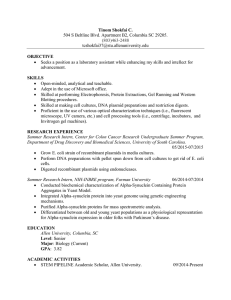
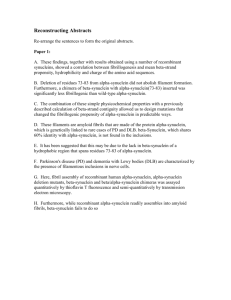
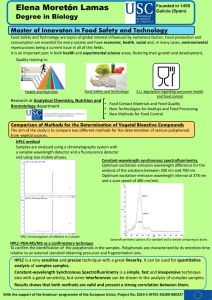
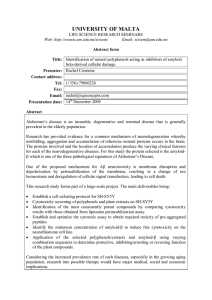
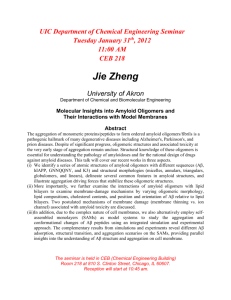


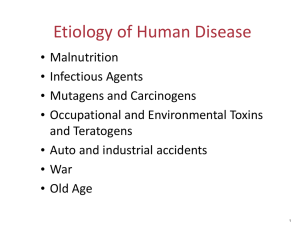
![Anti-alpha Synuclein (phospho S129) antibody [MJF- R13 (8-8)] ab168381](http://s2.studylib.net/store/data/012624200_1-8b4d3beea2c25d88fba831182bf6deb7-300x300.png)